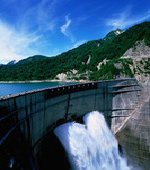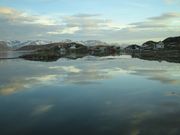 Global water estimates 'uncertain'
Global water estimates 'uncertain'
Great uncertainty exists regarding estimates of the global water budget (the amount of water involved in the hydrological cycle every year) because of discrepancies between global atmosphere and ocean models, and direct observations, a study has found.
Furthermore, these uncertainties may worsen as the number of water measurement stations around the world decrease — providing fewer opportunities to verify modelling data on the ground, according to the authors of the study, which was published in the latest edition of theJournal of Hydrometeorology.
Christof Lorenz and Harald Kunstmann, from the Karlsruhe Institute of Technology and the Institute for Meteorology and Climate Research in Germany, analysed three of the most widely used modern global atmosphere and ocean models, and compared precipitation and temperature estimates made with them for the period 1989–2006 with direct observations made over the same time-frame.
They found large discrepancies between the two. In some regions, figures for mean precipitation deviated by up to four litres per square metre.
The models play a key role in hydrological and hydrometeorological research, assimiliating large quantities of historical observational data.
The study highlights that "other studies use [such] models for climate trend studies. We show clearly that such calculations are very dangerous and should not be performed".
"We also think that differences between water budget estimates are an indication that our understanding of global and larger scale regional water cycles is still insufficient," Lorenz and Kunstmann told SciDev.Net.
Paulo Artaxo, professor of environmental physics at the University of São Paulo, Brazil, told SciDev.Net: "We are still far from understanding the spatial and temporal distribution of precipitation. The models are quite limited in this regard".
Lorenz and Kunstmann say that "there is still a great need to develop and advance global models, and thus long-term funding … must be ensured".
Discrepancies between model-based and direct water budget estimates have also been exacerbated by the decline in the number of global measurement stations.
In South America, for example, the number of stations has fallen from 4,350 to 550 (a decrease of more than 84 per cent). And according to Kunstmann and Lorenz, large swathes of tropical Africa remain completely unobserved, while over Asia, monitoring station distribution is still very sparse.
"In most cases, the reduction in measurement stations might be explained by insufficient funding", say the authors.
The authors did not include a separate study of the situation in the Middle East, but believe that the number of stations in the region has also decreased, due to "political conflicts", as well as inadequate funding.
--
| Abstract |
|---|
The three state-of-the-art global atmospheric reanalysis models, namely, ERA-Interim (ECMWF), MERRA (NASA), and CFSR (NCEP) are analyzed and compared with independent observations in the period between 1989 and 2006. Comparison of precipitation and temperature estimates from the three models with gridded observations reveals large differences of the reanalyses and also of the observation data sets. A major source of uncertainty in the observations is the spatial distribution and change of the number of gauges over time. In South America, active measuring stations were reduced from 4267 to 390. The quality of precipitation estimates from the reanalyses strongly depends on the geographic location, as there are significant differences especially in tropical regions. The closure of the water cycle in the three reanalyses is analyzed by estimating long-term mean values for precipitation, evapotranspiration, surface runoff, and moisture flux divergence. Major shortcomings in the moisture budgets of the data sets are mainly due to inconsistencies of the net precipitation minus evaporation estimates over the land masses and oceans. This imbalance largely originates from the assimilation of radiance sounding data from the NOAA-15 satellite, which results in an unrealistic increase of oceanic P-E in the MERRA and CFSR budgets. Overall, ERA-Interim shows both a comparatively reasonable closure of the terrestrial and atmospheric water balance and a reasonable agreement with the observation data sets. The limited performance of the three state-of-the-art reanalyses in reproducing the hydrological cycle, however, puts the use of these models for climate trend analyses and long-term water budget studies into question.
* Corresponding author’s address: Christof Lorenz, Karlsruhe Institute of Technology, Institute for Meteorology and Climate Research, Kreuzeckbahnstraβe 19, 82467 Garmisch-Partenkirchen, Germany. E-mail: christof.lorenz@kit.edu,harald.kunstmann@kit.edu
| Contact information |
Catarina Chagas/ Christof Lorenz, Karlsruhe Institute of Technology, Institute for Meteorology and Climate Research, Kreuzeckbahnstraβe 19, 82467 Garmisch-Partenkirchen, Germany
(email: christof.lorenz@kit.edu ; harald.kunstmann@kit.edu) |
|---|---|
| News type | Inbrief |
| File link |
http://journals.ametsoc.org/doi/abs/10.1175/JHM-D-11-088.1 |
| Source of information | SciDev.Net / The Hydrological Cycle in Three State-of-the-art Reanalyses: Intercomparison and Performance Analysis Christof Lorenz1,* and Harald Kunstmann1,2 1 Karlsruhe Institute of Technology (KIT), Institute for Meteorology and Climate Research (IMK-IFU), Garmisch-Partenkirchen, Germany 2 Augsburg University, Institute of Geography, Augsburg, Germany |
| Keyword(s) | Reanalyses |
| Subject(s) | HYDRAULICS - HYDROLOGY , INFORMATION - COMPUTER SCIENCES , MEASUREMENTS AND INSTRUMENTATION , METHTODOLOGY - STATISTICS - DECISION AID , NATURAL MEDIUM , RISKS AND CLIMATOLOGY , TOOL TERMS , WATER DEMAND |
| Relation | http://dx.doi.org/10.1175/JHM-D-11-088.1 |
| Geographical coverage | Germany, |
| News date | 09/07/2012 |
| Working language(s) | ENGLISH |
 you are not logged in
you are not logged in





